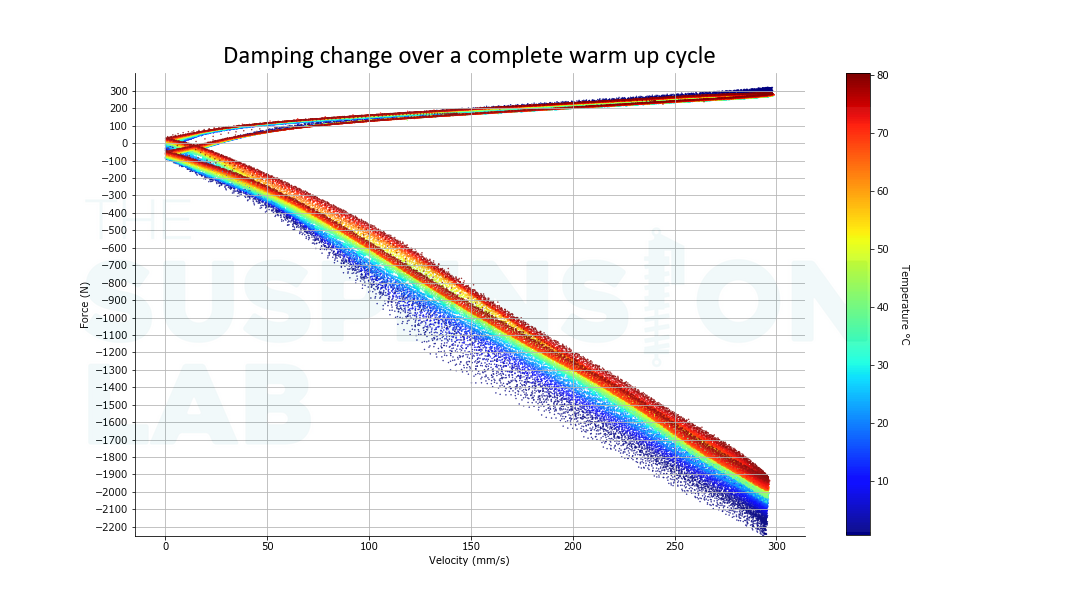Effects of temperature on suspension performance
It is fairly well known that your suspension changes as it heats up or cools down. It can be slow and boggy in the cold or harsh and fast in the heat. Many people will also know that oils get thinner when they are warmer so this is assumed to be the main cause. As part of our aim to provide the best service and performance from your suspension, we spend hours upon hours doing testing in the lab and on the trail to isolate and understand this kind of phenomenon so we can come up with the best ways to deal with them.
To test how your damping changes as the shock heats up we set up a test where the shock was placed in a freezer to cool down below zero, then mounted in the dyno and run up to 300mm/s. The shock warms up quickly* due to the heat created from damping and we measure the changes in force over that time. On trail testing with an IR thermometer shows that shocks operate around 20*C - 40*C for most people, so taking in to consideration some extreme conditions we decided to run the test from 0*C to 60*C.
The oils used were as follows-
Maxima PRO RSF 3 wt - the factory oil for the Rockshox Kage R used in testing it has a Viscosity of 14 cSt @ 40*C and VI of 385
“Hot oil” Pink - High performance aftermarket oil, 14cSt and VI 404
Redline sample - Pre-production sample of an ultra thin damper oil with extremely high VI in excess of 600
WPL 10 wt - Not typically suggested for shock use but included for comparison, 32cSt and VI 211
This example plot shows the change in damping relative to temperature, and you can see there is change over the course of the whole test. Compression damping is less effected than rebound but it does change slightly. The typical range you would reach on the trails is in the light blue to turquoise region. For reference, 1 click of rebound adjustment usually shifts the curve roughly 30 - 100N.
Below is a plot of the peak damping forces generated as the shock heats up. This is at the fastest point in the stroke during the test to make it easier to compare the different oils
From this perspective we can see there is a real change but it isn’t huge for the “proper” shock oils. The redline especially has very little drop in force as it heats up, even over the whole test. The other 2 performed well and this is what we would expect given the specs of the oil. The WPL oil had a much larger variance, which would almost definitely be noticed and is also the only one to have an appreciable difference on the compression side.
These changes alone are probably not enough to adversely affect suspension but many riders will report drastic changes in performance in extreme or wildly changing conditions. This is most likely caused by the air spring(s) in your shock**. Gasses increase in pressure as temperature rises and it is a significant amount. Here is a calculated graph of a typical shock spring curve that was inflated to 150psi at room temperature but is then cooled to 0C and heated to 50C. This is quite a change! The sag measurement and ride height will alter by around 4mm at the shock, and the actual pressure goes from 140 up to 165 psi!***
In conclusion, your suspension behaviour will change in many ways as it heats up or cools down, so remember this if you are riding in significantly different weather to normal or notice a drop off in performance. A change to high performing oil will help a small amount but the also consider the ambient temperature when you inflate your shock versus what it will reach in use. Even on very cold days an air shock will easily warm up close to the operating temperatures of a warmer day.
-While the damping changes are fairly small, they are not zero and are also opposing the spring changes. eg A hotter shock loses rebound damping as well as becoming firmer so the net change is compounded and what you feel is larger than either of those on their own.
-If you are checking pressure at the trail head on a particularly cold day, you may want to try starting with a slightly lower pressure than normal
-The first descent you do on a cold day may possibly feel pretty awful but don’t change anything based on this unless you are sure it has come up to temperature (which is only a matter of 10-30 seconds in most cases!)
-Also, if you drive to the trail with your bike on the outside of the car, the wind chill will reduce its temperature even further!
-Coil shocks will still experience a small increase in spring force, due to the pressure from the IFP acting on the shaft. The amount will depend on the diameter of the shaft but is a smaller effect than in an air shock.
*While a shock will build up a lot of heat very quickly on the dyno, in the real world air flow has a massive cooling effect so it stabilises quite quickly.
**The lubricating oils in your fork and shock also change with temperature, as does the friction from seals but that is a study for another day.
***This is calculated for dry air, but humidity will also influence the exact result
Some points were left out of the post to save space but they have been included in this file - Temperature Notes



